The following is a guest post from Zach Whalen Assistant Professor of English, University of Mary Washington his teaching and research focuses on the critical study and practice of digital media in a variety of genres, including video games, electronic literature, comics, and transmedia. You can find him on twitter @zachwhalen.
In the underwater city of Rapture, in the exclusive Mercury Suites neighborhood of Olympus Heights, there lived a “Mr. Beauchamp.” There, with his wife and three daughters, Mr. Beauchamp sought to build a life under the sea. But alas, as readers will no doubt already have guessed, things do not end well for the Beauchamp family, for at some point prior to the arrival in Rapture of a mysterious man named Jack, the Beauchamps sought to escape the horror around them through a red bottle of poison — what must have seemed like the only option. Like their neighbors Anna Culpepper and Brigid Tenenbaum, the Beauchamps own a television, and this is where we as players of Bioshock(2007) encounter them — arrayed near their TV set in a grisly domestic dioramatic presentation of mass suicide.
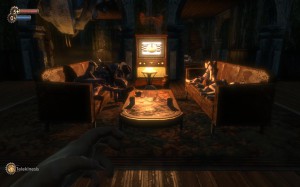
The Beauchamps and their apartment play no role in the plot of Bioshock, and unlike some other tragic subplots (the Lutz family, for instance), there are no audio diaries to explain what happened. But their presence, appearance and arrangement raise some interesting questions, and seeking answers to those questions through some analysis of their formal material composition illuminates Bioshock‘s implicit critical use of media history. Therefore, I want to show how a close reading/playing of this video game space can reveal nuances of larger themes in a game.
To begin with, the name I am using for this family is not visible anywhere in the game. Neither is it arbitrary, however. All one sees upon exploring the second floor of Mercury Suites, across the atrium from Tenenbaum, is an apartment with an obscured nameplate hanging above its door. SinceBioshock for PC is built using the Unreal Engine, every planar surface is an image stored somewhere in the game data in a more or less standard format. Using the UModel tool to explore the data for Olympus Heights (the package named, “6-Resi.bsm”), I eventually discovered that the nameplate above the door is an object called “plaquedirty,” and after some trial error with the UModel tool, I managed to export its two texture files into bitmaps of reasonably detailed resolution. I noticed that the traces on the “plaquedirty_normal.tga” image bore the appearance of letters, and after confirming that the other address plaques use a bold, embossed Palatino, I can assert with some confidence that the original text on the plaque, though it appears mostly erased and obscured, originally read, “C Beauchamp.”

As far as I can tell, there is no “Beauchamp” in Bioshock lore. There are no search results on the exhaustive Bioshock Wikia site, at least, and none of the game’s credits indicate that it might be the name of a programmer or artist. If this is an Easter Egg, in other words, it’s quite an obscure one. My best guess, and it’s a stretch, is that this could reference photographer Anthony Beauchamp.1
So lacking a definite reference, what else can be said of this “plaquedirty”? Typographically, its use of Palatino, an oldstyle serif font by Hermann Zapf, is period-appropriate for the 1950s. One could speculate reasons for its being “dirty”: on one hand, a level artist given the task of adding plausible detail to the game’s diegesis without also inventing unintentional toe-holds for new story material created instead a record of inscription and erasure. But on the other hand, within the game, this means that the world of Rapture includes a family or individual of such affluence as to live among the city’s elite, but with such noteriety, infamy or perhaps banality that their name and all reference to them has been blotted out of existence.
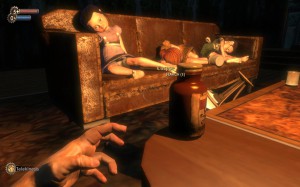
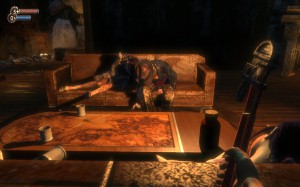
What else do we know of the family themselves? Arrayed on the couches are five figures: two adults and three almost-identical little girls. These girls might be triplets, or it might simply be that they all share the body model of a Little Sister as she appears after being rescued. The adults are splicers in an early state of decay, but the girls are relatively pristine and mannequin-like. The girls corpses are searchable (they have candy), but like the furniture and the bottle of poison on the coffee table, their bodies are impossible to pick up with telekinesis or to move in any other way. The adults, on the other hand, can be manipulated just like any other splicers. This difference raises a question: are these actually the girls’ parents? For that matter, are these really the little girls that used to live here, or are they dead Little Sisters, as their character models suggest, that someone has posed here for some reason? Indeed, the staging of this well-preserved domestic tranquility is somewhat reminiscent of the macabre vignettes created by one of the Beauchamp’s other neighbors, Sander Cohen.
Of course, because it’s a space in a game level, this is a vignette composed in order to make a particular impression on its viewers, and as such, the Beauchamp’s living room touches on a handful of cultural references. The half-full cups invoke the horror of the Jonestown mass suicide, for example, and the television set might be based on an RCA model. If it is, there is some uncanny resonance in RCA Victor’s “His Master’s Voice” logo, since at the time the player will encounter the Beauchamps, Jack’s health and power are being damaged by voice commands issued from Frank Fontaine.
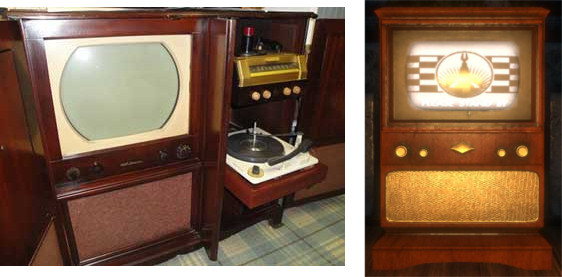
What I’m more interested in, though, is how this scene depicts 1950s domesticity with TV at the center, and moreover how this scene communicates what a contemporary game designer and audience expect of a 1950s domestic scene. In this sense, the Beauchamps’ living room calls to mind the living room diorama in Disney’s Spaceship Earth, an attraction where the progress of communication technology looks forward (and backward) in ways that reflect the dominant paradigms or even corporate perspectives of the present.
Currently2 Spaceship Earth’s family of mannequins are watching the moon landings from the stylish comfort of a 1960s living room (below left), but an older version (below right) places them floating in darkness, their gazes fixed on the TV in front of them while disembodied screens of televisions future and past float into view on a wall to their left like a gentler, blander version of aNam June Paik installation.

[CC licensed image by Flickr user Elizabeth/Table4Five]
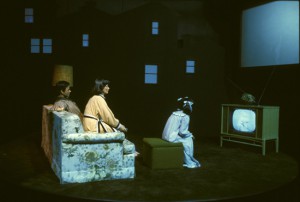
A link between Bioshock and Disney may actually be productive for several reasons — Andrew Ryan does somewhat resemble Walt Disney, key scripted events often occur while the player watches from behind glass or while forced into a track like on a Disney ride, and much of the character movement in the game has an artificial, animatronic feel. In Bioshock 2’s version of Disney Land, “Ryan Amusements,” the house of horrors, “Journey to the Surface” even includes a television as the focal point of one scene of domestic security that is obliterated by the visible hand of “the parasite.”
But Spaceship Earth’s 1960s living room locates its family in a historically and culturally specific moment, and as such provides a nice example of what Lynn Spigel has written of as the postwar emergence of the television as the central figure in popular representations of family relationships. Not only is the family brought together by television, they are brought together in a special room designated and arranged specifically for this purpose.
Spigel traces a link between domestic interiority and media technology that begins in Victorian drawing rooms, but more recently, Erkki Huhtamo connects this emergence of private media apparatus — the modes of looking, hearing and participating imposed on the user — to video games, arguing that their arrival in homes of the 1970s first required a space for them to occupy, and that this space has its origins in the 19th century. Furthermore, for Huhtamo, the domestic ideology of private media use has a gendered orientation that relies on a construction of masculinity as the one who provides his family with knowledge of the world in absence of their ability to go out and experience it directly. Michael Newman picks up this thread as well. It is the father who works hard all day to bring home a zoetrope or new stereopticon slides for his family’s amusement and education, just as it is the young boy who enjoys his mother’s failure to master Space Invaders. Video game advertising from this period is also filled with examples of families gathered around screens, combining the metanarrative of the television at the center family relationships with the socially constructed togetherness of the family game night.
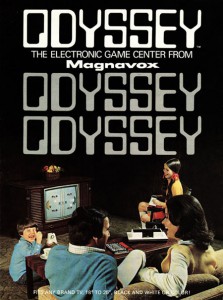
So what do the Beauchamps argue about domestic media ideologies of the 1950s or about 2007′s perception of those ideologies? The television set anchors the design of the room, and its gently flickering screen draws the players eye open first entering the apartment. But the two couches are arranged in parallel, facing one another across a coffee table with the TV off to the side. This is a space designed for conversation, not consumption, and with two occupied couches, the Beauchamp family is drawn into a complete domestic circle. With the exception of one girl’s blank stare in the TV’s general direction, the family looks inward. There’s even a lamp on the table near the TV that casts glare on the TV’s screen, obscuring whatever imagery might ordinarily appear there.3 In a contrasting arrangement, Anna Culpepper, who presumably lives alone, hides her TV away in a dedicated media room. There, her furniture is situated to face the screen directly.
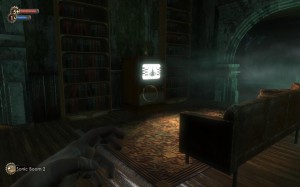
From all this evidence of togetherness, one might conclude that the Beauchamps were a happy family, but I don’t think this is the case. Their TV is more likely an attempt at keeping up appearances than it is a genuine focal point of interest. According to a source Spigel quotes, an average television set would have cost around $238 in the mid 1950s. So while it’s still a major purchase for the Beauchamps, a TV is a solid upper middle class status symbol, especially for a family that can afford the rent at Mercury Suites. (The specific model for the Beauchamp’s television is conveniently labeled “High_Rent_TV”.) Also, the Beauchamps have even upgraded their TV with an enhanced sound system; note the ornamental speaker horns positioned above it that, again, reinforce a possible association with “His Master’s Voice.”
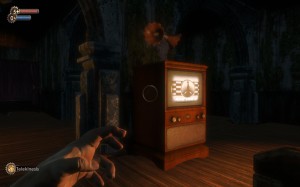
For the Beauchamps, I suspect all this is for show. Mr. Beauchamp is a splicer of the“Breadwinner” model, which in other cases is generically characterized through his unsuccessful, megalomaniacal capitalist ascendancy. Mrs. Beauchamp, on the other hand, is a “Lady Smith”model, a stereotype of white upper-class privilege prone toward racist and classist remarks. It’s not hard to imagine that Mr. Beauchamp is a failed businessman, and that Mrs. Beauchamp now sees her marriage as a move in the wrong direction on the social ladder. Despite their charming family room, well-applianced kitchen, and beautiful children, I think the Beauchamps ultimately saw their lives as a metaphorical cell within their underwater prison of Rapture.
Despite all this, I must admit that I find the Beauchamps oddly sympathetic in their macabre tranquility. Amid the chaos of the Mercury Suites level, their deceptively peaceful togetherness and the horror it hides struck me in a way I wasn’t prepared for as I replayed Bioshock this past spring semester with one of my classes. As a father — two girls (4 and 2) and a 1-year old boy — I guess I can’t help but respond emotionally to suggestions of violence toward children. This is part of the reason why this scene, probably designed as an afterthought or space filler, manages to be affective and interesting, at least for me. Beyond that, though, it’s a model of a media-historical moment, since it’s created at a time when the fundamentals of that apparatus — the single cathode-ray screen — have transitioned into obsolescence through the proliferation of large flat-screen TVs and smaller, personal viewing devices.
Ultimately, the Beauchamps leave several important questions unanswered: what was Mr. Beauchamp’s line of work? What sort of programming did they watch on their TV? Why weren’t the girls converted to Little Sisters, or were they? Did the parents poison their girls out of mercy, and if so, did the girls know they were drinking poison? Did their mother serve it to them before drinking her own dose, or did they all drink at the same time? I suspect the answers to these questions are not forthcoming in the Bioshock canon. Perhaps the best we can do is, for a time, follow the Beauchamp’s TV’s invitation to “Please Stand By” and reflect on what their lives and deaths have to say about domestic ideology, obsolescence, and representations of media history in video games.
[1] Anthony Beauchamp was a well-connected photographer (he married Winston Churchill’s daughter) who captured several famously sexy images of Marilyn Monroe in the early 1950s. Bioshock’s “C Beauchamp” lives among Rapture’s elite, including the celebrity performer, Anna Culpepper, and there seems to be a concentration of camera equipment in and around the Beauchamp’s apartment, including a camera and some film in their bathtub. Also, according to this article, Anthony Beauchamp committed suicide in 1957, not long before C Beauchamp would have.
[2] I have not personally experienced Spaceship Earth in many, many years, so my knowledge of its current content is just based on what I could find or guess at on Flickr.
[3] Mass media of some form exists in Rapture, since there are references to theater and film and at least one newspaper. It’s not clear if television programming would have been completely locally produced or if they would have been allowed to receive broadcast signals from the world beyond, but since Rapture is in the middle of the North Atlantic, my guess is it’s probably out of range for most over the air broadcasts.
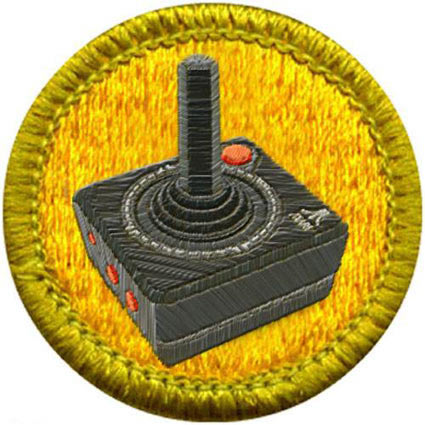
Got a great idea for a post you think our readers would love? Want to be a guest writer for Play the Past?

The ride at “Ryan Amusements” was a clear nod to Spaceship Earth. The ride vehicles are very similar, the scenes are ’80s Epcot all the way, and even the track’s path is reminiscent of the real-life ride (going on an incline at the beginning).
It’s interesting that you mentioned RCA Victor and His Master’s Voice, both famous as record labels. When you enter the Beauchamp apartment for the first time, Noël Coward’s “The Party’s Over Now” will play.
Coward first recorded a full-length version of the song in the 1930s for “Victor Records”. However, the version used in Bioshock is only 30 seconds long and comes from the Columbia Records album, Noel Coward in New York, made in 1959.
It was also heard earlier in the first level in the Footlight Theater when the Big Daddy throws a splicer through the window.
Truly when someone doesn’t be aware of after that its up to
other users that they will help, so here it happens.